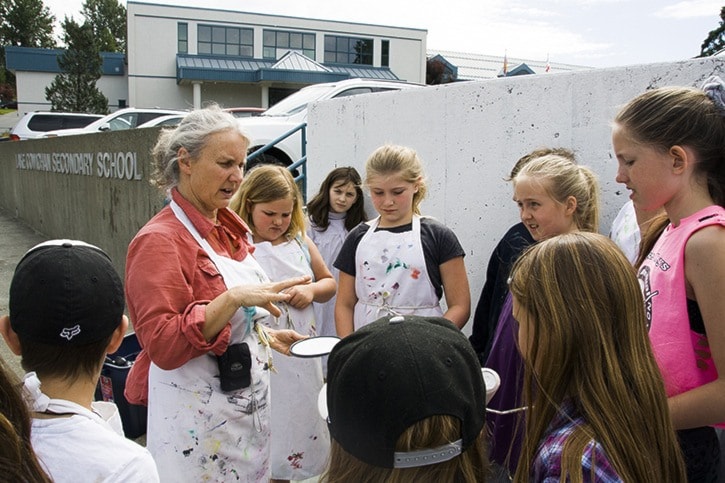Work at Lake Cowichan School has begun on a large mural that will be on full display for the whole town to see, and every student from fourth graders to this year’s grad class will have a hand in bringing it life.
By now anyone driving west of A&W has likely seen the changes underway on the concrete wall that runs below the school’s parking lot and basketball courts, along South Shore Road. Last week the wall was white washed and then given a coat of orange under paint. Now comes the fun part, when the mural’s images are outlined and filled in. The question on most minds right now: What are those images going to be?
“It’s going to be a mural of Lake Cowichan’s history the kids are compiling, and the official unveiling is going to be during Lake Days,” said Sean Battye, history teacher at LCS.
Battye is the faculty member spearheading the initiative, which has brought an artist-in-residence into the school specifically to work on this mural.
“I’ve always had it in the back of my mind that we have this ugly grey wall out front and could we do something? I’m a history teacher so I thought why not the history of Lake Cowichan?”
Ewa Sniatycka is the artist in residence for the mural, and has done similar art space residencies with other schools (École Mount Prevost, Alex Aiken Elementary, and St. Joseph’s Chemainus Catholic Elementary School to name just a few) and community organizations. Her specialty is “inquiry-based projects,” which require using drawing and writing as a base of inquiry or investigation.
In this case, Sniatycka first met with the different Grade 4 to Grade 7 classes to discuss their vision and ideas for the mural. Then the older students worked with the museum and public library to choose images they felt best represented a timeline of the Lake’s history.
“My job really is to facilitate the painting process and also try to conceptualize the composition or the structure of all these various kinds of events. How to make it connect together,” said Sniatycka.
It was the students who decided they wanted the mural to be a timeline-style history of the Lake over the past 200 years, which will include the history of the local First Nation, pre-contact.
However, said Battye, “we didn’t want a Chemainus-style of murals like panels.”
For that reason, they decided to separate the images in each part of the mural using trees, which will also reflect the historical significance of the forest industry in this region. The mural will begin on the left hand side and be “read” to the right, like a book, so will start with the natural landscape and the First Nations of the area, then move forward in time to the present.
“I think the kids will see… the town and the area has gone through certain eras that have been prosperous and decline and then prosperous,” said Battye, adding that some students discussed including images of the Lake’s future, although ultimately the group decided not to. At least for now.
Sniatycka said one of the main benefits of a project like this is it allows students to realize their ideas in different ways than reading and writing. She said it’s an opportunity for students to thrive who may have less academic learning styles.
“It gives people opportunities for conversations, too,” she said. “A lot of times when we’re engaged in a process — even preliminary conversations — there’s opportunities for conversation around the topic, which is a really great way to learn. We learn from each other and not just one person.”
The mural project is funded by ArtStarts in Schools, a not-for-profit organization. The project has also received funding from the school’s parent advisory committee and the school district. Battye said if any members of the community want to make a financial donation to the project, the group would happily put the money to good use.
